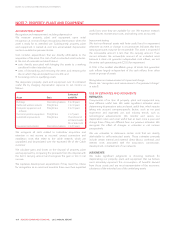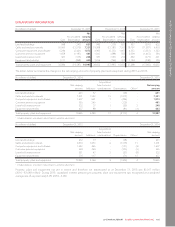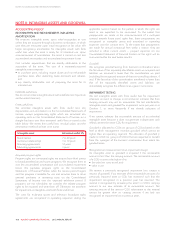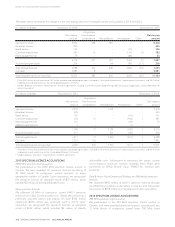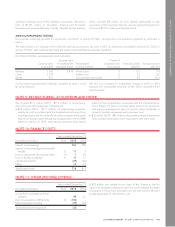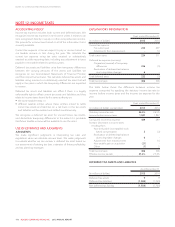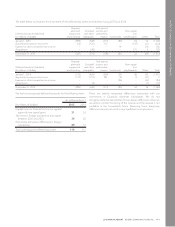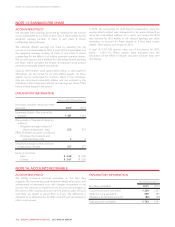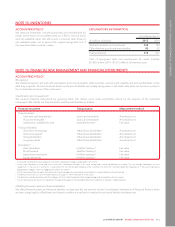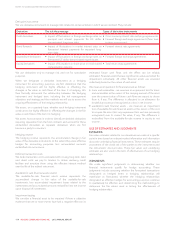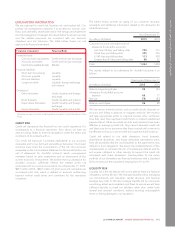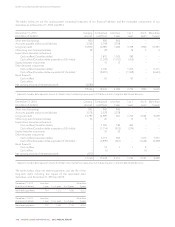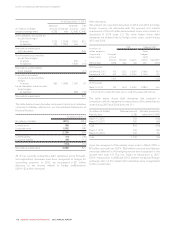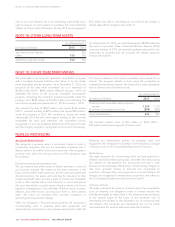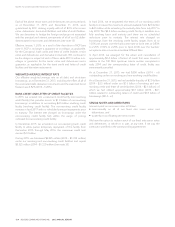Rogers 2015 Annual Report Download - page 116
Download and view the complete annual report
Please find page 116 of the 2015 Rogers annual report below. You can navigate through the pages in the report by either clicking on the pages listed below, or by using the keyword search tool below to find specific information within the annual report.
NOTES TO CONSOLIDATED FINANCIAL STATEMENTS
Derivative instruments
We use derivative instruments to manage risks related to certain activities in which we are involved. They include:
Derivative The risk they manage Types of derivative instruments
Debt derivatives • Impact of fluctuations in foreign exchange rates on
principal and interest payments for US dollar-
denominated long-term debt
• Cross-currency interest rate exchange agreements
• Forward foreign exchange agreements (from time
to time as necessary)
Bond forwards • Impact of fluctuations in market interest rates on
forecasted interest payments for expected long-
term debt
• Forward interest rate agreements
Expenditure derivatives • Impact of fluctuations in foreign exchange rates on
forecasted US dollar-denominated expenditures
• Forward foreign exchange agreements
Equity derivatives • Impact of fluctuations in share price on stock-based
compensation expense
• Total return swap agreements
We use derivatives only to manage risk, and not for speculative
purposes.
When we designate a derivative instrument as a hedging
instrument for accounting purposes, we first determine that the
hedging instrument will be highly effective in offsetting the
changes in fair value or cash flows of the item it is hedging. We
then formally document the relationship between the hedging
instrument and hedged item, including the risk management
objectives and strategy and the methods we will use to assess the
ongoing effectiveness of the hedging relationship.
We assess, on a quarterly basis, whether each hedging instrument
continues to be highly effective in offsetting the changes in the fair
value or cash flows of the item it is hedging.
We assess host contracts in order to identify embedded derivatives
requiring separation from the host contracts and account for these
embedded derivatives as separate derivatives when we first
become a party to a contract.
Hedging reserve
The hedging reserve represents the accumulated change in fair
value of the derivative instruments to the extent they were effective
hedges for accounting purposes, less accumulated amounts
reclassified into net income.
Deferred transaction costs
We defer transaction costs associated with issuing long-term debt
and direct costs we pay to lenders to obtain revolving credit
facilities and amortize them using the effective interest method
over the life of the related instrument.
Available-for-sale financial assets reserve
The available-for-sale financial assets reserve represents the
accumulated change in fair value of the available-for-sale
investments, less accumulated impairment losses related to the
investments and accumulated amounts reclassified into net income
upon disposal of investments.
Impairment testing
We consider a financial asset to be impaired if there is objective
evidence that one or more events have had a negative effect on its
estimated future cash flows and the effect can be reliably
estimated. Financial assets that are significant in value are tested for
impairment individually. All other financial assets are assessed
collectively based on the nature of each asset.
We measure impairment for financial assets as follows:
•loans and receivables – we measure an impairment loss for loans
and receivables as the excess of the carrying amount of the asset
over the present value of future cash flows we expect to derive
from it, if any. The difference is allocated to an allowance for
doubtful accounts and recognized as a loss in net income.
•available-for-sale financial assets – we measure an impairment
loss of available-for-sale financial assets as the excess of the cost
to acquire the asset (less any impairment loss we have previously
recognized) over its current fair value, if any. The difference is
reclassified from the available-for-sale reserve in equity to net
income.
USE OF ESTIMATES AND JUDGMENTS
ESTIMATES
Fair value estimates related to our derivatives are made at a specific
point in time based on relevant market information and information
about the underlying financial instruments. These estimates require
assessment of the credit risk of the parties to the instruments and
the instruments’ discount rates. These fair values and underlying
estimates are also used in the tests of effectiveness of our hedging
relationships.
JUDGMENTS
We make significant judgments in determining whether our
financial instruments qualify for hedge accounting. These
judgments include assessing whether the forecasted transactions
designated as hedged items in hedging relationships will
materialize as forecasted, whether the hedging relationships
designated as effective hedges for accounting purposes continue
to qualitatively be effective, and determining the methodology to
determine the fair values used in testing the effectiveness of
hedging relationships.
114 ROGERS COMMUNICATIONS INC. 2015 ANNUAL REPORT


